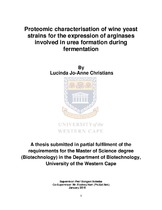| dc.contributor.advisor | Ndimba, Bongani | |
| dc.contributor.author | Christians, Lucinda Jo-Anne | |
| dc.date.accessioned | 2018-08-06T09:34:57Z | |
| dc.date.available | 2018-08-31T22:10:06Z | |
| dc.date.issued | 2018 | |
| dc.identifier.uri | http://hdl.handle.net/11394/6194 | |
| dc.description | Magister Scientiae - MSc (Biotechnology) | |
| dc.description.abstract | Wine is a fermented beverage widely consumed all over the world as a recreational drink, but is known
for its health benefits to humans. However, wine contain urea, a by-product of arginine hydrolysis by
arginases expressed during fermentation by the wine yeast Saccharomyces cerevisiae, which reacts
spontaneously with ethanol to form ethyl carbamate (EC). Ethyl carbamate was implicated in toxicity and
carcinogenicity. Subsequently, small scale (18 L) Sauvignon Blanc and Cabernet Sauvignon winemaking
trials using commercial wine yeasts were initialised during the 2014 and 2015 vintages to measure urea
in final wines. The overall aim of this study was to investigate wine yeast protein expression during
alcoholic fermentation and establish a possible correlation between urea formation by wine yeast and
up/down regulated yeast proteins. Ion-exchange chromatography in conjunction with spectrophotometry
was used to measure urea levels in bottled wines. The yeast strain, Prise de Mousse (PdM) was shown to
be the lowest urea producer in both Sauvignon Blanc and Cabernet Sauvignon wines. | |
| dc.language.iso | en | |
| dc.publisher | University of the Western Cape | |
| dc.title | Proteomic characterisation of wine yeast
strains for the expression of arginases
involved in urea formation during
fermentation | |
| dc.rights.holder | University of the Western Cape | |

